A Study of Spatio-Temporal Differentiation Characteristics and Driving Factors of Shaanxi Province’s Traditional Heritage Villages
Abstract
1. Introduction
2. Materials and Methods
2.1. Study Area
2.2. Data Sources and Processing
2.3. Methods
2.3.1. Kernel Density Methods
2.3.2. Standard Deviation Ellipse
2.3.3. Spatial Autocorrelation Analysis
2.3.4. Geo-Detection Model
3. Results
3.1. Spatial Distribution Features of Traditional Villages
3.2. Evolution of Spatio-Temporal Pattern of Traditional Villages
3.3. Driving Factors of Traditional Villages
3.3.1. Detection of Driving Factors
3.3.2. Physical Factors of Traditional Villages
3.3.3. Socio-Economic Factors of Traditional Villages
4. Discussion
4.1. Spatial Distribution and Evolution Characteristics of Traditional Villages
4.2. Multiple Factors Jointly Affect Traditional Villages
4.3. The Influence of Culture on Traditional Villages
4.4. Protection Policies
5. Conclusions
Author Contributions
Funding
Institutional Review Board Statement
Informed Consent Statement
Data Availability Statement
Conflicts of Interest
References
- Bian, J.J.; Chen, W.X.; Zeng, J. Spatial Distribution Characteristics and Influencing Factors of Traditional Villages in China. Int. J. Environ. Res. Public Health 2022, 19, 4627. [Google Scholar] [CrossRef] [PubMed]
- Chen, X.H.; Xie, W.Z.; Li, H.B. The spatial evolution process, characteristics and driving factors of traditional villages from the perspective of the cultural ecosystem: A case study of Chengkan Village. Habitat Int. 2020, 104, 102250. [Google Scholar] [CrossRef]
- Xie, X.B.; Li, X.J. The formation and transformation of “Cultural Matrix” in traditional villages. J. Hunan Univ. (Soc. Sci.) 2019, 33, 126–133. [Google Scholar]
- Xu, Y.Q.; Yang, X.Y.; Feng, X.H.; Yan, P.; Shen, Y.; Li, X.L. Spatial distribution and site selection adaptation mechanism of traditional villages along the Yellow River in Shanxi and Shaanxi. River Res. Appl. 2022, 1–13. [Google Scholar] [CrossRef]
- Gao, C.G.; Wu, Y.; Bian, C.L.; Gao, X.X. Spatial characteristics and influencing factors of Chinese traditional villages in eight provinces the Yellow River flows through. River Res. Appl. 2021, 1–15. [Google Scholar] [CrossRef]
- Ma, H.D.; Tong, Y.Q. Spatial differentiation of traditional villages using ArcGIS and GeoDa: A case study of Southwest China. Ecol. Inform. 2022, 68, 101416. [Google Scholar] [CrossRef]
- Long, H.L.; Tu, S.S.; Ge, D.Z.; LI, T.T.; Liu, Y.S. The allocation and management of critical resources in rural China under restructuring: Problems and prospects. J. Rural Stud. 2016, 47 Pt B, 392–412. [Google Scholar] [CrossRef]
- Wang, B.; Shi, W.Z.; Miao, Z.L. Confidence Analysis of Standard Deviational Ellipse and Its Extension into Higher Dimensional Euclidean Space. PLoS ONE 2015, 10, e0118537. [Google Scholar] [CrossRef]
- Ma, Y.; Huang, Z.X. Research on spatial distribution and accessibility of the traditional villages in the urban agglomeration on the middle reaches of the yangtze river based on GWR model. Hum. Geogr. 2017, 32, 78–85. [Google Scholar]
- Barrientos, F.; Martin, J.; Luca, C.D.; Tondelli, S.; Gómez-García-Bermejo, J.; Casanova, E.Z. Computational methods and rural cultural & natural heritage: A review. J. Cult. Herit. 2021, 49, 250–259. [Google Scholar] [CrossRef]
- Sardaro, R.; Sala, P.L.; Pascale, G.D.; Facclongo, N. The conservation of cultural heritage in rural areas: Stakeholder preferences regarding historical rural buildings in Apulia, southern Italy. Land Use Policy 2021, 109, 105662. [Google Scholar] [CrossRef]
- Amit-Cohen, L.; Sofer, M. Cultural heritage and its economic potential in rural society: The case of the kibbutzim in Israel. Land Use Policy 2016, 57, 368–376. [Google Scholar] [CrossRef]
- Palombini, A. Storytelling and telling history. Towards a grammar of narratives for Cultural Heritage dissemination in the Digital Era. J. Cult. Herit. 2017, 24, 134–139. [Google Scholar] [CrossRef]
- Quintana, D.C.; Díaz-Puente, J.M.; Gallego-Moreno, F. Architectural and cultural heritage as a driver of social change in rural areas: 10 years (2009–2019) of management and recovery in Huete, a town of Cuenca, Spain. Land Use Policy 2022, 115, 106017. [Google Scholar] [CrossRef]
- Bender, O.; Boehmer, H.J.; Jens, D.; Schumacher, K.P. Using GIS to analyze long-term cultural landscape change in Southern Germany. Landsc. Urban Plan. 2005, 70, 111–125. [Google Scholar] [CrossRef]
- Wang, D.G.; Zhu, Y.J.; Zhao, M.F.; Lv, Q.Y. Multi-dimensional hollowing characteristics of traditional villages and its influence mechanism based on the micro-scale: A case study of Dong cun Village in Suzhou, China. Land Use Policy 2022, 101, 105146. [Google Scholar] [CrossRef]
- Ju, X.X.; Yang, C.C.; Zhao, M.W.; Xu, Y.; Zhou, D.M.; Zhang, Y.W. Spatial Distribution Characteristics and Influencing Factors of Traditional Villages in Zhejiang, Anhui, Shaanxi, Yunnan Provinces. Econ. Geogr. 2022, 42, 222–230. [Google Scholar]
- Xu, J.; Yang, M.S.; Hou, C.P.; Lu, Z.L.; Liu, D. Distribution of rural tourism development in geographical space: A case study of 323 traditional villages in Shaanxi, China. Eur. J. Remote Sens. 2021, 54 (Suppl. S2), 318–333. [Google Scholar] [CrossRef]
- Xue, M.Y.; Wang, C.X.; Dou, W.S.; Wang, Z.H. Spatial distribution characteristics of traditional villages in the Yellow River basin and influencing factors. J. Arid Land Resour. Environ. 2020, 34, 94–99. [Google Scholar] [CrossRef]
- Li, L.L.; Zhang, J.Q. Image simulation of traditional villages Spatial layout based on Computer Numerical Analysis. Mob. Inf. Syst. 2022, 2022, 5873846. [Google Scholar] [CrossRef]
- Fu, J.; Zhou, J.L.; Deng, Y.Y. Heritage values of ancient vernacular residences in traditional villages in Western Hunan, China: Spatial patterns and influencing factors. Build. Environ. 2021, 188, 107473. [Google Scholar] [CrossRef]
- Liu, C.; Cao, Y.J.; Yang, C.; Zhou, C.; Ai, M.C. Pattern identification and analysis for the traditional village using low altitude UAV-borne remote sensing: Multifeatured geospatial data to support rural landscape investigation, documentation and management. J. Cult. Herit. 2020, 44, 185–195. [Google Scholar] [CrossRef]
- Zheng, X.Y.; Wu, J.H.; Deng, H.B. Spatial Distribution and Land Use of Traditional Villages in Southwest China. Sustainability 2021, 13, 6326. [Google Scholar] [CrossRef]
- Pei, Y.F.; Gong, K.; Leng, J.W. Study on the inter-village space of a traditional village group in Huizhou Region: Hongguan Village group as an example. Front. Archit. Res. 2020, 9, 588–605. [Google Scholar] [CrossRef]
- Hardle, W.; Simar, L. Applied Multivariate Statistical Analysis, 22nd ed.; Springer: Berlin, Germany, 2007. [Google Scholar]
- He, Y.B.; Zhang, T.; Xiong, D.M. Evaluation on cultural value of traditional villages and differential revitalization: A case study of Jiaozuo City, Henan Province. Econ. Geogr. 2020, 40, 230–239. [Google Scholar]
- Gao, J.; Wu, B.H. Revitalizing traditional villages through rural tourism: A case study of Yuanjia Village, Shaanxi Province, China. Tour. Manag. 2017, 63, 223–233. [Google Scholar] [CrossRef]
- Chen, Y.G. An analytical process of spatial autocorrelation functions based on Moran’s index. PLoS ONE 2021, 16, e0249589. [Google Scholar] [CrossRef]
- Chen, Y.G. New framework of GetisOrd’s indexes associating spatial autocorrelation with interaction. PLoS ONE 2020, 15, e0236765. [Google Scholar] [CrossRef]
- Wang, J.F.; Zhang, T.L.; Fu, B.J. A measure of spatial stratified heterogeneity. Ecol. Indic. 2016, 67, 250–256. [Google Scholar] [CrossRef]
- Song, B.; Ren, Y.Y.; Feng, M. Spatial Characteristics and Influencing Factors of Traditional Villages in Loess Plateau Gully Area: A Case of National Traditional Villages in Yulin City of Shaanxi Province. Areal Res. Dev. 2021, 40, 162–168. [Google Scholar]
- Zhang, P.; Li, J.; Zhang, Z.H. Spatial-Temporal Distribution Characteristics and Influencing Factors of Traditional Villages in Qinling-Daba Mountains. J. Hum. Settl. West China 2020, 25, 116–124. [Google Scholar]
- Xiang, Y.L.; Cao, M.M.; Yan, F.; Sun, F. Study on Spatio-temporal Characteristics and Protection Strategies of Traditional Villages in Shaanxi Province. Urban Stud. 2019, 26, 27–31. [Google Scholar]
- Filloramo, R.; Becker, V.; Curci, A. Apulian prehistoric community connections: Preliminary results of GIS analysis and field activity. J. Archaeol. Sci. Rep. 2020, 32, 102380. [Google Scholar] [CrossRef]
- Yang, Y.; Hu, J.; Liu, D.J.; Li, Y.J.; Chen, Y.; Hu, S.L. Spatial differentiation of ethnic traditional villages in Guizhou province and the influencing factors. J. Arid Land Resour. Environ. 2022, 36, 178–185. [Google Scholar]
- Lin, M.S.; Jian, J.S.; Yu, H.; Zeng, Y.F.; Lin, M.L. Research on the Spatial Pattern and Influence Mechanism of Industrial Transformation and Development of Traditional Villages. Sustainability 2021, 13, 8898. [Google Scholar] [CrossRef]
- Fu, X.L. Cognitive research on spatial morphology of traditional villages based on ecological perspective. Fresenius Environ. Bull. 2021, 30, 2285–2289. [Google Scholar]
- Yang, X.; Song, K.; Pu, F.A. Laws and Trends of the Evolution of Traditional Villages in Plane Pattern. Sustainability 2020, 12, 3005. [Google Scholar] [CrossRef]
- Nie, Z.Y.; Li, N.; Pan, W.; Yang, Y.S.; Chen, W.; Hong, C.L. Quantitative Research on the Form of Traditional Villages Based on the Space Gene-A Case Study of Shibadong Village in Western Hunan, China. Sustainability 2022, 14, 8965. [Google Scholar] [CrossRef]
- Li, T.; Li, C.K.; Zhang, R.; Cong, Z.; Mao, Y. Spatial heterogeneity and influence factors of traditional villages in the Wuling Mountain area, Hunan Province, China based on Multiscale Geographically Weighted Regression. Buildings 2023, 13, 294. [Google Scholar] [CrossRef]
- Li, S.Y.; Song, Y.H.; Xu, H.; Li, Y.J.; Zhou, S.K. Spatial distribution characteristics and driving factors for traditional villages in areas of China based on GWR Modeling and Geodetector: A case study of the Awa Mountain Area. Sustainability 2023, 15, 3443. [Google Scholar] [CrossRef]
- Lu, Y.; Ahmad, Y. Heritage protection perspective of sustainable development of traditional villages in Guangxi, China. Sustainability 2023, 15, 3387. [Google Scholar] [CrossRef]

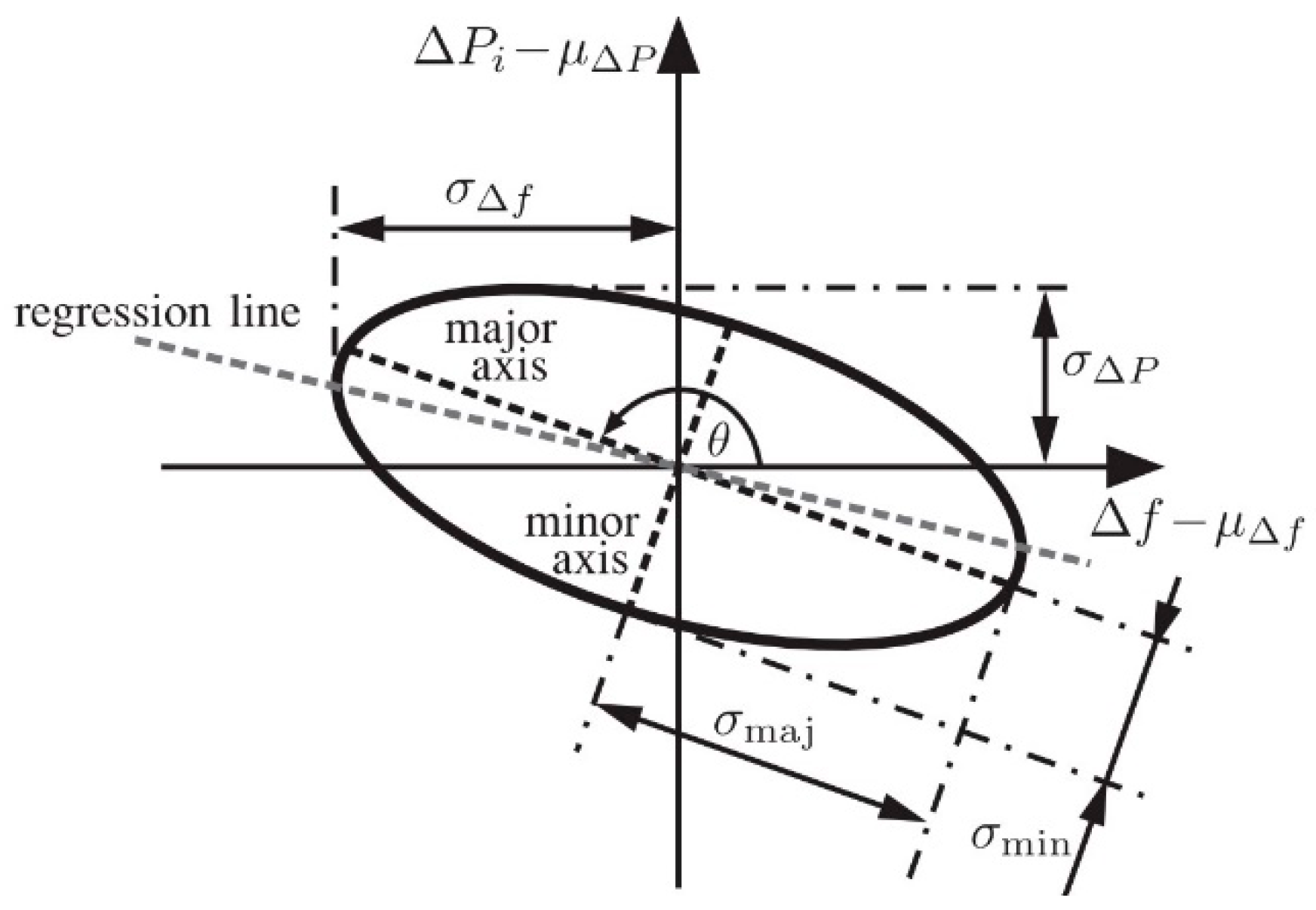


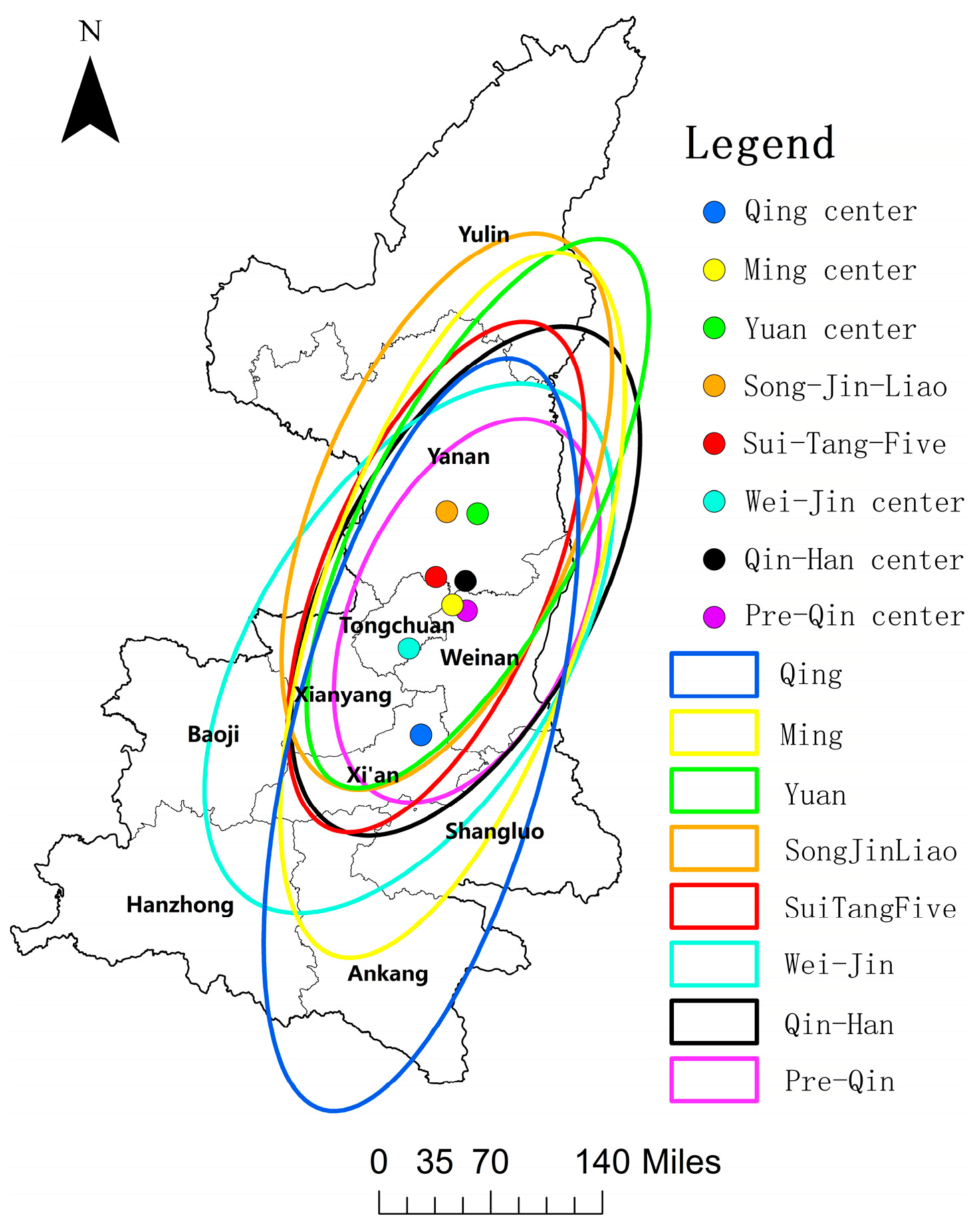
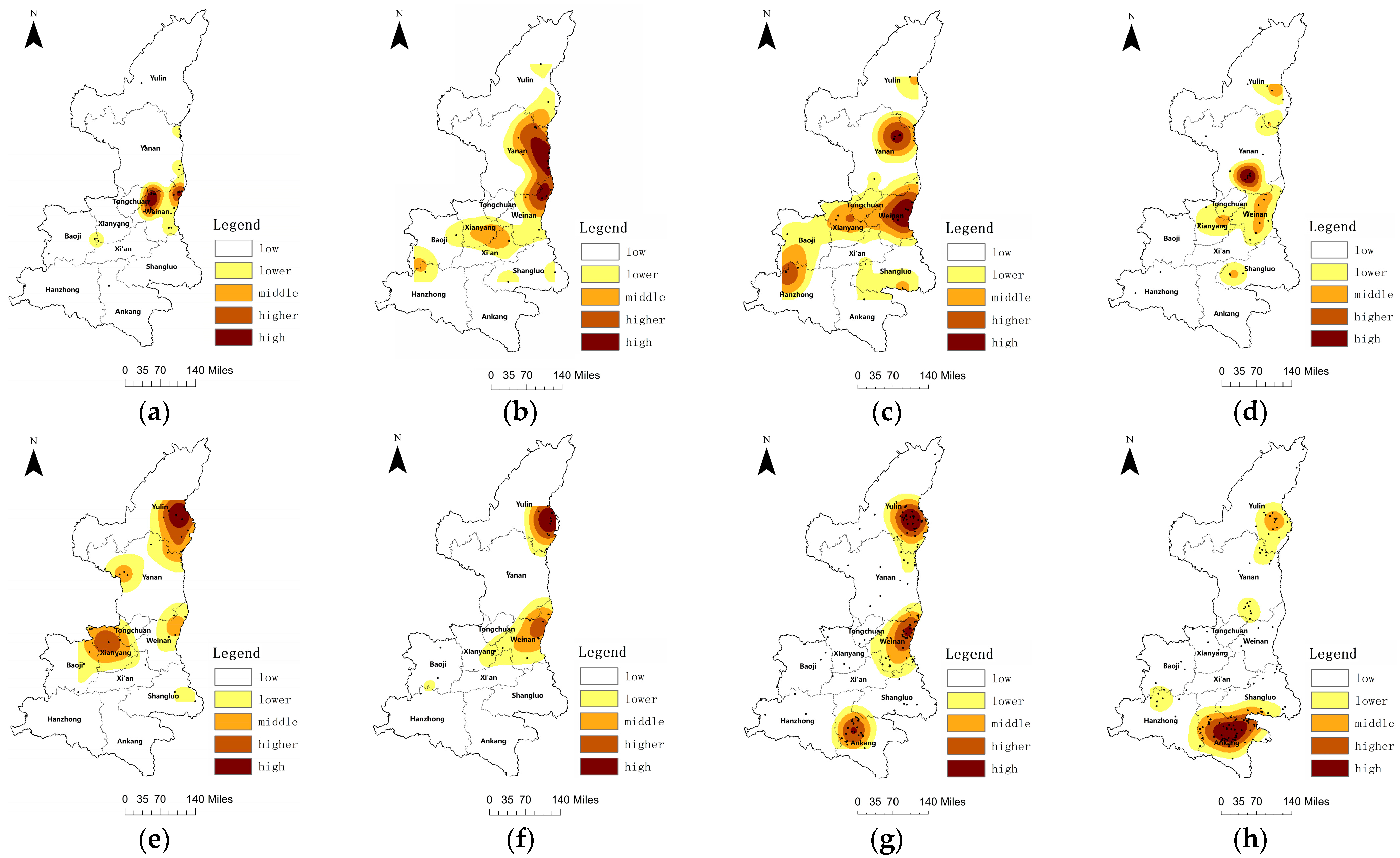
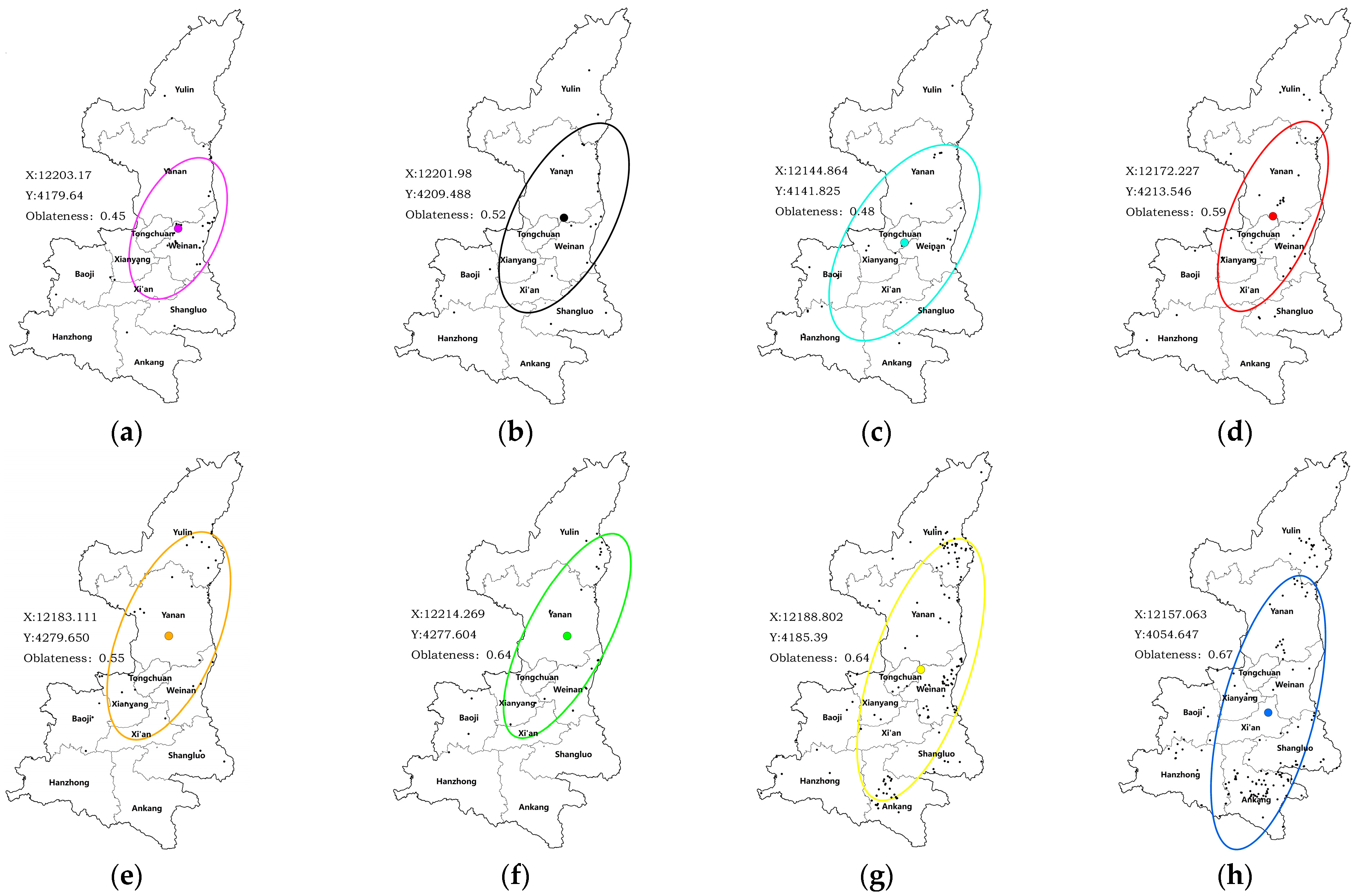


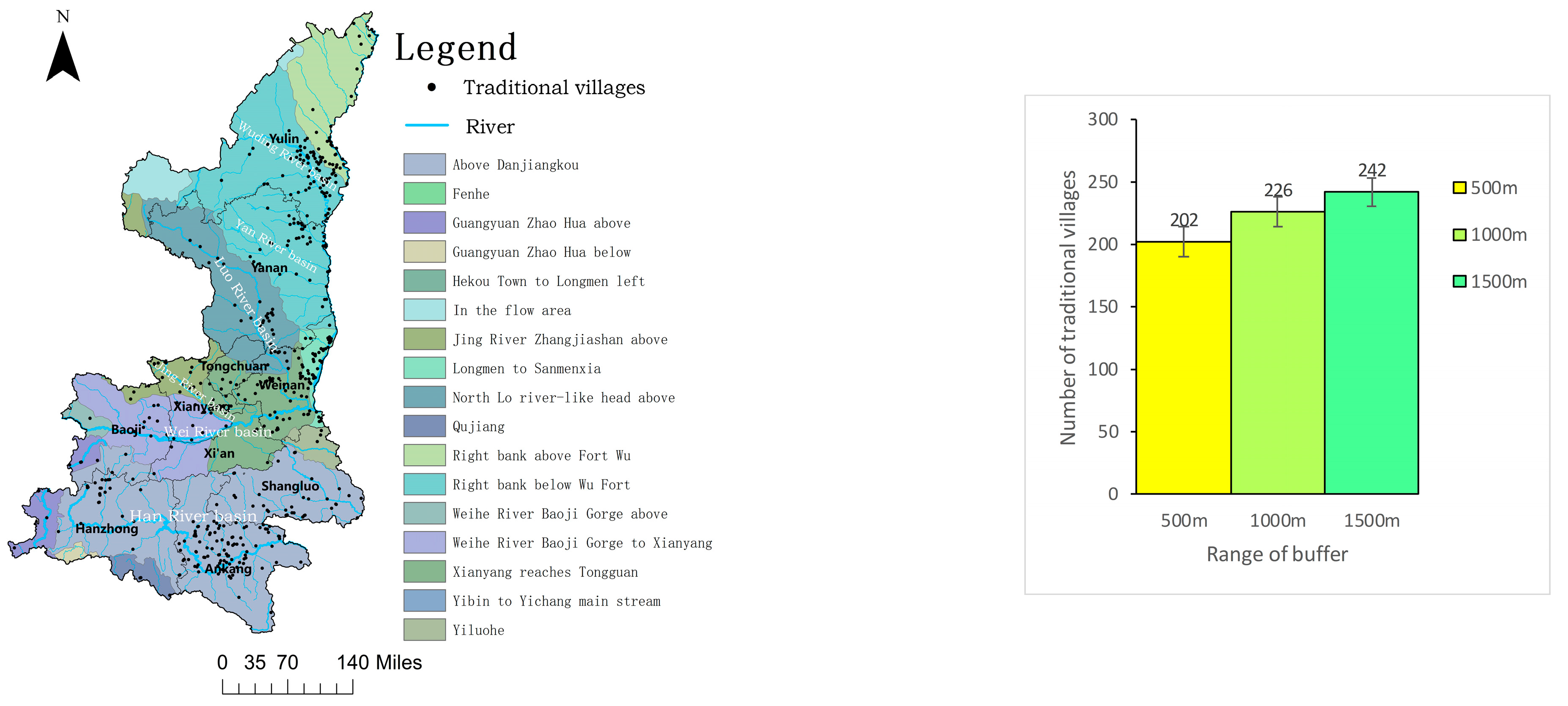
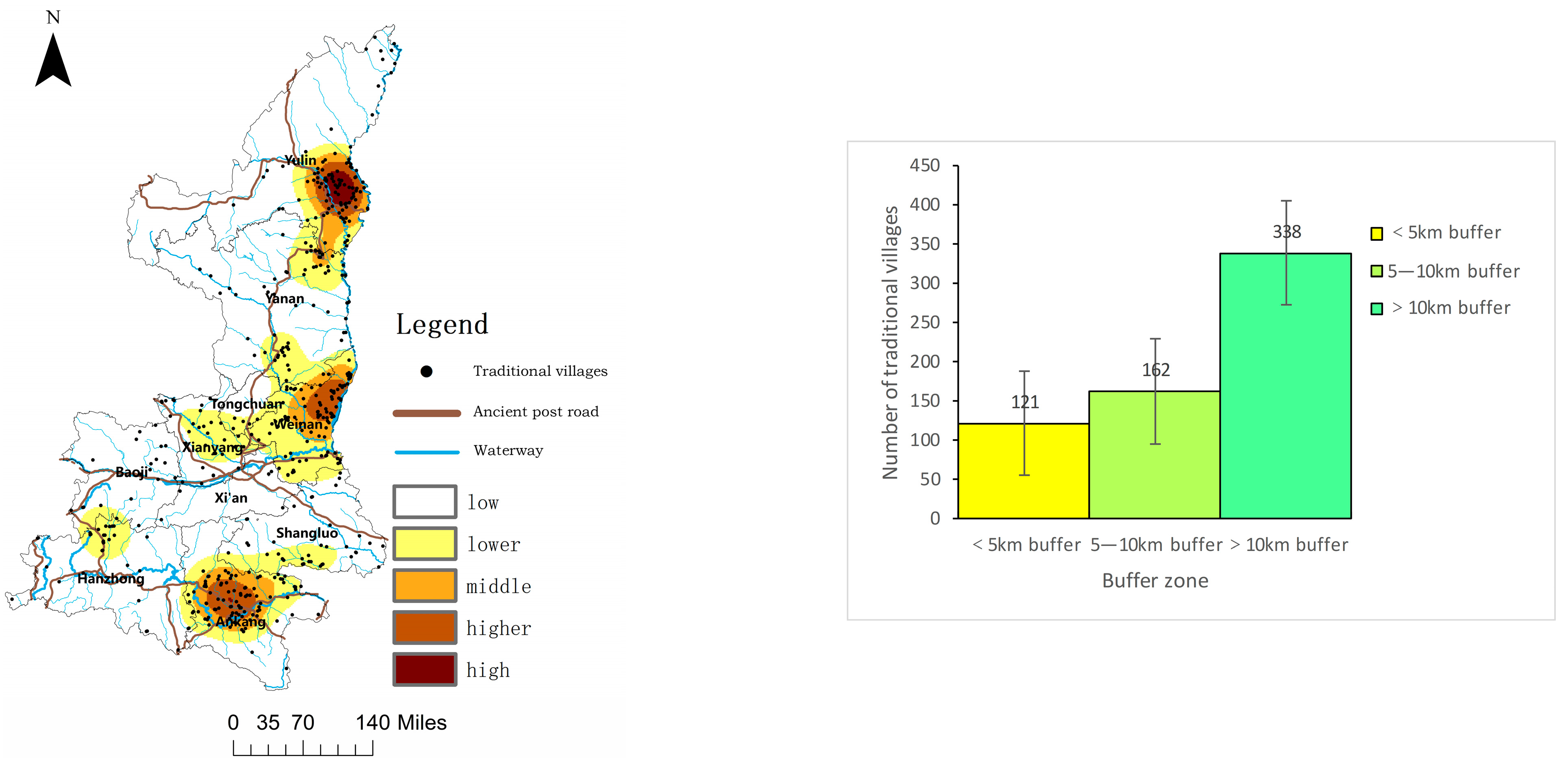


| Cities | Pre-Qin | Qin-Han | Wei-Jin | Sui-Tang-Five | Song-Jin-Liao | Yuan | Ming | Qing | Total |
|---|---|---|---|---|---|---|---|---|---|
| Ankang | 1 | 0 | 1 | 0 | 0 | 0 | 25 | 59 | 86 |
| Hanzhong | 1 | 1 | 4 | 2 | 0 | 1 | 7 | 17 | 33 |
| Weinan | 20 | 5 | 7 | 10 | 3 | 9 | 39 | 4 | 97 |
| Yan’an | 6 | 8 | 5 | 10 | 7 | 2 | 11 | 17 | 66 |
| Yulin | 1 | 2 | 2 | 7 | 10 | 9 | 39 | 23 | 93 |
| Xi’an | 0 | 2 | 0 | 0 | 1 | 0 | 1 | 2 | 6 |
| Tongchuan | 0 | 0 | 1 | 1 | 0 | 0 | 3 | 0 | 5 |
| Shangluo | 1 | 2 | 3 | 3 | 2 | 0 | 7 | 18 | 36 |
| Baoji | 1 | 2 | 2 | 1 | 3 | 2 | 3 | 4 | 18 |
| Xianyang | 3 | 1 | 3 | 4 | 7 | 2 | 6 | 5 | 31 |
| Variables | Factors | Value of q | Value of p |
|---|---|---|---|
| X1 | Altitude | 0.2171 | 0.000 |
| X2 | Slope | 0.0093 | 0.971 |
| X3 | River | 0.1352 | 0.000 |
| X4 | Ancient Transport | 0.0842 | 0.023 |
| X5 | Distance from central city | 0.0774 | 0.005 |
| X6 | Gross Domestic Product | 0.3128 | 0.000 |
| Dynasty | Total Number of Villages (Individual) | Distance within 1000 m (Individual) | Percentage (%) |
|---|---|---|---|
| Pre-Qin | 34 | 14 | 41 |
| Qin–Han | 23 | 12 | 52 |
| Wei–Jin | 28 | 14 | 50 |
| Sui–Tang–Five | 38 | 16 | 42 |
| Song–Jin–Liao | 33 | 20 | 60 |
| Yuan | 25 | 7 | 28 |
| Ming | 141 | 64 | 45 |
| Qing | 149 | 61 | 41 |
Disclaimer/Publisher’s Note: The statements, opinions and data contained in all publications are solely those of the individual author(s) and contributor(s) and not of MDPI and/or the editor(s). MDPI and/or the editor(s) disclaim responsibility for any injury to people or property resulting from any ideas, methods, instructions or products referred to in the content. |
© 2023 by the authors. Licensee MDPI, Basel, Switzerland. This article is an open access article distributed under the terms and conditions of the Creative Commons Attribution (CC BY) license (https://creativecommons.org/licenses/by/4.0/).
Share and Cite
Feng, X.; Hu, M.; Somenahalli, S.; Bian, X.; Li, M.; Zhou, Z.; Li, F.; Wang, Y. A Study of Spatio-Temporal Differentiation Characteristics and Driving Factors of Shaanxi Province’s Traditional Heritage Villages. Sustainability 2023, 15, 7797. https://doi.org/10.3390/su15107797
Feng X, Hu M, Somenahalli S, Bian X, Li M, Zhou Z, Li F, Wang Y. A Study of Spatio-Temporal Differentiation Characteristics and Driving Factors of Shaanxi Province’s Traditional Heritage Villages. Sustainability. 2023; 15(10):7797. https://doi.org/10.3390/su15107797
Chicago/Turabian StyleFeng, Xiaogang, Moqing Hu, Sekhar Somenahalli, Xinyuan Bian, Meng Li, Zaihui Zhou, Fengxia Li, and Yuan Wang. 2023. "A Study of Spatio-Temporal Differentiation Characteristics and Driving Factors of Shaanxi Province’s Traditional Heritage Villages" Sustainability 15, no. 10: 7797. https://doi.org/10.3390/su15107797
APA StyleFeng, X., Hu, M., Somenahalli, S., Bian, X., Li, M., Zhou, Z., Li, F., & Wang, Y. (2023). A Study of Spatio-Temporal Differentiation Characteristics and Driving Factors of Shaanxi Province’s Traditional Heritage Villages. Sustainability, 15(10), 7797. https://doi.org/10.3390/su15107797







